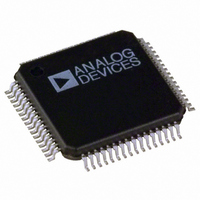AD9248BSTZ-65 Analog Devices Inc, AD9248BSTZ-65 Datasheet - Page 18

AD9248BSTZ-65
Manufacturer Part Number
AD9248BSTZ-65
Description
IC ADC 14BIT DUAL 65MSPS 64-LQFP
Manufacturer
Analog Devices Inc
Specifications of AD9248BSTZ-65
Data Interface
Parallel
Number Of Bits
14
Sampling Rate (per Second)
65M
Number Of Converters
2
Power Dissipation (max)
600mW
Voltage Supply Source
Single Supply
Operating Temperature
-40°C ~ 85°C
Mounting Type
Surface Mount
Package / Case
64-LQFP
Resolution (bits)
14bit
Input Channel Type
Differential
Supply Voltage Range - Analogue
2.7V To 3.6V
Supply Voltage Range - Digital
2.25V To 3.6V
Supply Current
200mA
Sampling Rate
65MSPS
Rohs Compliant
Yes
Lead Free Status / RoHS Status
Lead free / RoHS Compliant
For Use With
AD9248BST-65EBZ - BOARD EVAL WITH AD9248BST-65AD9248BCP-65EBZ - BOARD EVAL WITH AD9248BCP-65
Lead Free Status / RoHS Status
Lead free / RoHS Compliant, Lead free / RoHS Compliant
Available stocks
Company
Part Number
Manufacturer
Quantity
Price
Company:
Part Number:
AD9248BSTZ-65
Manufacturer:
ADI
Quantity:
513
Company:
Part Number:
AD9248BSTZ-65
Manufacturer:
Analog Devices Inc
Quantity:
10 000
Part Number:
AD9248BSTZ-65
Manufacturer:
ADI/亚德诺
Quantity:
20 000
AD9248
The minimum common-mode input level allows the AD9248 to
accommodate ground-referenced inputs. Although optimum
performance is achieved with a differential input, a single-
ended source may be driven into VIN+ or VIN−. In this
configuration, one input accepts the signal, while the opposite
input should be set to midscale by connecting it to an
appropriate reference. For example, a 2 V p-p signal may be
applied to VIN+, while a 1 V reference is applied to VIN−. The
AD9248 then accepts an input signal varying between 2 V and
0 V. In the single-ended configuration, distortion performance
may degrade significantly as compared to the differential case.
However, the effect is less noticeable at lower input frequencies and
in the lower speed grade models (AD9248-40 and AD9248-20).
Differential Input Configurations
As previously detailed, optimum performance is achieved while
driving the AD9248 in a differential input configuration. For
baseband applications, the AD8138 differential driver provides
excellent performance and a flexible interface to the ADC. The
output common-mode voltage of the AD8138 is easily set to
AVDD/2, and the driver can be configured in a Sallen-Key filter
topology to provide band limiting of the input signal.
At input frequencies in the second Nyquist zone and above, the
performance of most amplifiers is not adequate to achieve the
true performance of the AD9248. This is especially true in IF
under-sampling applications where frequencies in the 70 MHz
to 200 MHz range are being sampled. For these applications,
differential transformer coupling is the recommended input
configuration, as shown in Figure 32.
The signal characteristics must be considered when selecting a
transformer. Most RF transformers saturate at frequencies
below a few MHz, and excessive signal power can also cause
core saturation, which leads to distortion.
Single-Ended Input Configuration
A single-ended input may provide adequate performance in
cost-sensitive applications. In this configuration, there is a
degradation in SFDR and distortion performance due to the
large input common-mode swing. However, if the source
impedances on each input are matched, there should be little
effect on SNR performance.
2V p-p
Figure 32. Differential Transformer Coupling
49.9Ω
0.1µF
1kΩ
1kΩ
50Ω
10pF
50Ω
10pF
VINA
VINB
AD9248
AVDD
AGND
Rev. A | Page 18 of 48
CLOCK INPUT AND CONSIDERATIONS
Typical high speed ADCs use both clock edges to generate a
variety of internal timing signals and, as a result, may be
sensitive to the clock duty cycle. Commonly, a 5% tolerance is
required on the clock duty cycle to maintain dynamic
performance characteristics.
The AD9248 provides separate clock inputs for each channel.
The optimum performance is achieved with the clocks operated
at the same frequency and phase. Clocking the channels
asynchronously may degrade performance significantly. In
some applications, it is desirable to skew the clock timing of
adjacent channels. The AD9248’s separate clock inputs allow for
clock timing skew (typically ±1 ns) between the channels
without significant performance degradation.
The AD9248-65 contains two clock duty cycle stabilizers, one
for each converter, that retime the nonsampling edge, providing
an internal clock with a nominal 50% duty cycle. When proper
track-and-hold times for the converter are required to maintain
high performance, maintaining a 50% duty cycle clock is
particularly important in high speed applications. It may be
difficult to maintain a tightly controlled duty cycle on the input
clock on the PCB (see Figure 23). DCS can be enabled by tying
the DCS pin high.
The duty cycle stabilizer uses a delay-locked loop to create the
nonsampling edge. As a result, any changes to the sampling
frequency require approximately 2 µs to 3 µs to allow the DLL
to acquire and settle to the new rate.
High speed, high resolution ADCs are sensitive to the quality of
the clock input. The degradation in SNR at a given full-scale
input frequency (f
calculated as
In the equation, the rms aperture jitter, t
sum square of all jitter sources, which includes the clock input,
analog input signal, and ADC aperture jitter specification.
Under-sampling applications are particularly sensitive to jitter.
For optimal performance, especially in cases where aperture
jitter may affect the dynamic range of the AD9248, it is
important to minimize input clock jitter. The clock input
circuitry should use stable references; for example, use analog
power and ground planes to generate the valid high and low
digital levels for the AD9248 clock input. Power supplies for
clock drivers should be separated from the ADC output driver
supplies to avoid modulating the clock signal with digital noise.
Low jitter, crystal-controlled oscillators make the best clock
sources. If the clock is generated from another type of source
SNR
INPUT
=
20
) due only to aperture jitter (t
×
log
⎡
⎢
⎣
(
2
×
π
×
f
1
INPUT
J
, represents the root-
×
t
j
)
⎤
⎥
⎦
J
) can be













